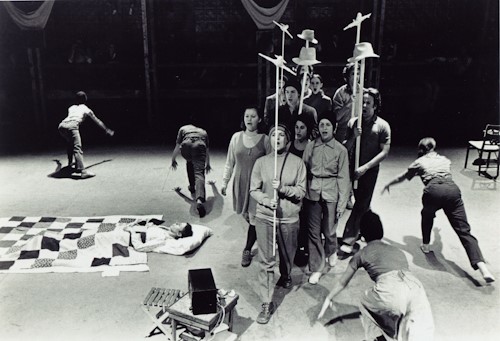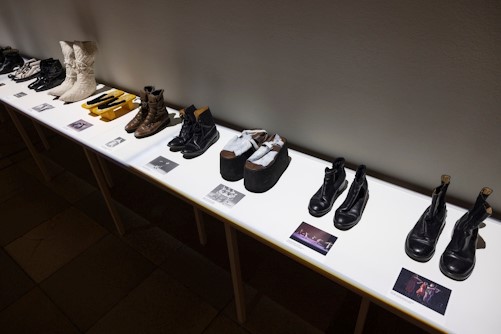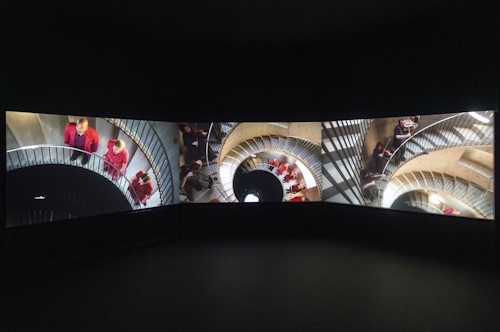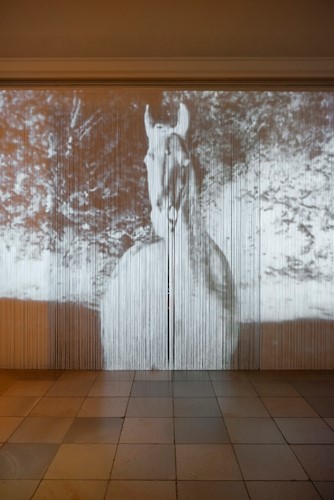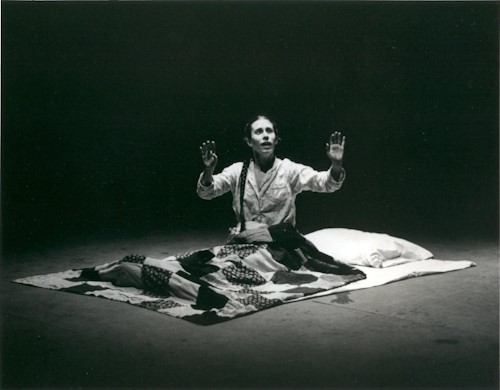Haus der Kunst, Munich
Meredith Monk began developing her innovative performance work in the mid-1960s. Since then, her approach has had a significant influence on generations of artists and performers. David Mead reports on an exhibition that celebrates the artist and her work.
“I work in between the cracks, where the voice starts dancing, where the body starts singing, where theatre becomes cinema.” Meredith Monk
Meredith Monk defies categorisation. Choreographer, certainly. Dancer, for sure. But also composer, singer, director and filmmaker. A pioneer of what is now called ‘interdisciplinary performance,’ she is an artist whose work has consistently and seamlessly integrated music, movement, and visuals in performances that are often come with great depth and are deeply moving. A groundbreaking figure in site-specific creations, and pioneer of vocal music and experimental theatre, the now 81-year-old continues to make innovative work to this day.
A collaboration with the Oude Kerk, Amsterdam and the Hartwig Art Foundation, Meredith Monk. Calling is a unique retrospective of her immersive creations. Across three large rooms, the Munich exhibition presents major creations from her catalogue, emphasising the cross-disciplinary way she likes to work, but also gives an insight into the artist herself.
The exhibition starts as soon as you enter. Offering Shrine, in the entrance of the Haus der Kunst was conceived as an audio-visual part of Indra’s Net (2023), the third and final work in a trilogy dedicated to our relationship with the natural world, following On Behalf of Nature (2013) and Cellular Songs (2018). Here it works as a stand-alone introduction, a meditation on the Earth’s ‘everyday objects’ in which hands open and close showing such as a few coins, an egg and a pipe.
Upstairs in the galleries, Meredith Monk. Calling offers a comprehensive overview of the artist’s diverse output including restagings in the form of Time Capsules of several of her early site-specific works.
One of the first and most striking exhibits is a recreation of the set for Quarry (1976), in which Monk played a bedridden American girl during World War II. As she laid on a quilt and pillow on the floor, surrounded by suitcases, floating white airplanes, and a lot of rubble, opera music playing through an old radio, the child’s isolation become a nightmare, her illness a metaphor for the darkness of the conflict. It’s striking how the set, even without its performers, evokes superbly not only the anxieties and atmosphere of that war but of recent events of our present times too.
The Archive Dream Room, the middle room of the exhibition, is reached by walking through a beaded doorway on which video of the emblematic white horse from ATLAS (1991) is projected. It really is like walking into the film.
Once inside, visitors will find reconstructed elements of Monk’s New York City loft. Fragments of her living and studio space provide an insight into her inspirations and creative process. The latter is revealed in fascinating plans for shows, one for Juice: a theatre cantata in three installments (1969) detailing audience seating and precise running arrangements. Other diverse material includes unpublished compositions, photographs, drawings, posters, films that frequently leave memorable images, recorded interviews, other objects and costumes, the latter including a shoe timeline.
Emphasising just how important music and other sound was in her work, the Archive Dream Room has many places where you can sit, pop on a pair of headphones, listen and immerse yourself in her work. Visitors are also invited to open the Singing Suitcase, which does indeed sing.
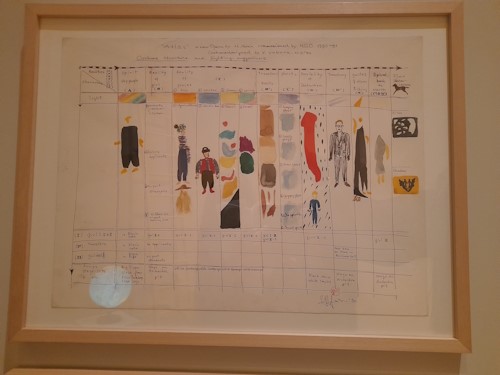
Photo David Mead
The most absorbing of the exhibition is at its deepest, however. The third gallery features what Monk calls ‘shrines.’ Dark, enclosed and soundproofed, these immersive spaces are like cocoons in which you can watch her films and listen on headphones. As you do so, it’s really easy to lose yourself in her world and her work. Some are so captivating that you find yourself wanting to watch a second time.
I was especially taken by the newly-created Songs of Ascension Shrine (2023), a three-screen video installation based on a 2007 performance by Monk and a company of musicians and singers in artist Ann Hamiton’s eighty-foot high tower in Geyserville, California. The film brings the magical performance space to vivid life. With performers stationed throughout its double-helix staircase, it becomes filled with sound. You really do feel part of the scene.
In other shrines, more video installations play on large screens. Rotation Shrine (2021), which Monk refers to as ‘connecting tissue’ for Indra’s Net is a prayer for the continuation of the Earth. It’s combining of black-and-white film of people constantly turning as if on rotating plinths and densely layered chanting is quite hypnotic.
Elsewhere, Volcano Songs Shrine (1994) considers ageing and transformation, a crowd of faces dissolving slowly from one to the next. Ideas of time passing never seem far away. The Politics of Quiet Shrine has a ritual feel, it’s cast of singer-dancers, instrumentalists and children acknowledging the end of the 20th century as they perform a rite of passage into the next.
There is so much more including ATLAS (1991), the pioneering video installation 16 Millimeter Earrings (1966/1998) and the poetic sound installation Silver Lake with Dolmen Music (1981).
There is a lot to see and take in. But, while Meredith Monk. Calling brings together reconstructions of set, video installations, sculptures, and archival material, it feels very cohesive. Everything has space.
It is also notable how her work feels simultaneously grand yet on an individual, human scale. Despite some of it now being over sixty years old, and perhaps surprisingly given the innovative, ground-breaking nature of it, it all feels remarkably fresh and incredibly arresting.
Accompanying the exhibition is a new book, Meredith Monk. Calling, available from January 2024. Edited by Anna Schneider, it will feature never-before-published archival material, musical notations, drawings, and photographs, as well as an interview with Monk and accompanying essays.
Also available is Meredith Monk – The Recordings, a 13-CD limited edition box set released by Munich-based ECM Recordings that brings together all Monk’s releases on the label since Dolmen Music (1981). Included is a 300-page book that reprises all the original CD notes, plus new texts and interviews.
Meredith Monk: Calling is at the Haus der Kunst, Munich to March 3, 2024
In Amsterdam, Meredith Monk: Calling is at Oude Kirk to March 17, 2024.


